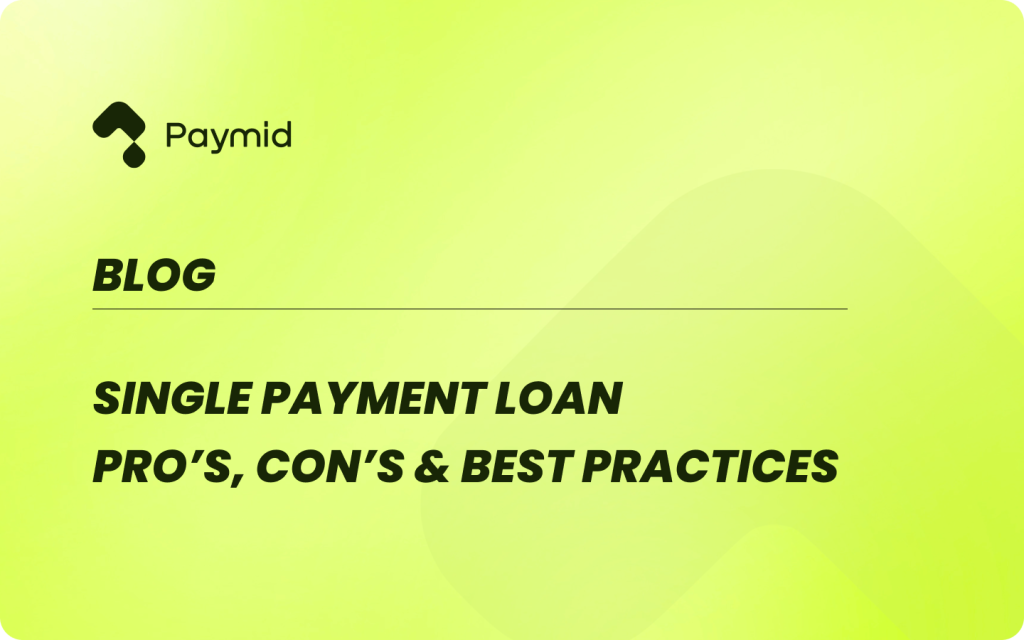Single Payment Loan: Pros, Cons, And Best Practices

Have you ever found yourself in a financial pinch, needing a quick influx of cash? We’ve all been there, and that’s where a single-payment loan might be useful. This short-term financing option has gained popularity among businesses and individuals alike, offering a way to bridge temporary cash flow gaps. As experts in the field, we’ve seen how these loans can be a game-changer for managing receivables and keeping operations running smoothly.
Key Takeaways
The Mechanics of Single Payment Loans
Single-payment loans are a unique type of short-term financing designed to cover immediate financial needs[1]. As professionals in the field, we’ve seen how these loans can be useful for managing cash flow, especially for businesses dealing with receivables or individuals facing unexpected expenses.
1. Loan Terms
The terms of a single-payment loan are straightforward. Unlike traditional installment loans, where you make regular payments over an extended period, a single-payment loan requires you to settle the entire amount in one lump sum. This usually happens by your next payday, which is typically within 2-4 weeks of receiving the loan.
One of the key features of these loans is their short repayment period. This brief term allows you to avoid long-term commitments and the accumulation of interest over time. It’s a quick fix for temporary cash flow issues, but it’s crucial to ensure you can repay the full amount when it’s due[2].
Most single-payment loans are unsecured, meaning you don’t need to provide any valuable assets as collateral. This makes them accessible to a wide range of borrowers, including those who might not have significant business assets to leverage.
The application process for a single-payment loan is typically simple and fast. You can often complete an online form, and approval processes happen quickly—sometimes in a matter of minutes or hours. Once approved, the funds are usually transferred straight into your bank account, giving you immediate access to the cash you need[3].
2. Interest Calculation
When it comes to interest calculation, single-payment loans often use a simple interest method. This means the interest is calculated based on the principal amount borrowed, rather than compounding over time.
To figure out how much you’ll owe, you can use this formula: Principal loan amount x Interest rate x Loan term in years = Interest. For example, if you borrow USD 1000.00 with a 15% interest rate for a 30-day term, your interest would be 1000 x 0.15 x (30/365) = USD 12.33[4].
It’s important to note that interest rates for single-payment loans can be quite high, often exceeding 400% when calculated as an annual percentage rate (APR). This is due to the short loan period and the perceived risk on the lender’s part.
3. Repayment Options
As the name suggests, you’re expected to repay the entire loan—principal plus interest and fees—in one lump sum by the agreed-upon due date.
If you can’t repay the loan on time, some lenders might offer a rollover option. This means you pay a fee to extend the loan term. However, we caution against this practice as it can lead to a cycle of debt. The rollover fee is added to your total loan amount, increasing what you owe.
For example, if you took out a USD 400.00 loan with a 20% interest fee, you’d initially owe USD 480.00. But if you can’t pay on time and choose to roll over the loan, you might face an additional USD 45.00 fee, bringing your new total to USD 525.00.
We always recommend having a solid repayment plan in place before taking out a single-payment loan. Make sure you know exactly how much you’ll need to pay back, including all fees and interest. Then, determine whether you can return the loan on the due date without compromising other financial obligations[5].
Remember, timely repayment is crucial. Missing payments can result in penalties and fines, and may also harm your credit score. This could impact your ability to secure professional services or other forms of financing in the future.
In conclusion, while single-payment loans can be a useful short-term financing option for managing receivables or unexpected expenses, they come with significant responsibilities. Understanding the mechanics of these loans is crucial for making informed financial decisions and maintaining healthy cash flow.
Read More:
- BNPL Explained: What Buy Now, Pay Later Means For Shoppers
- Credit Card Networks & Issuers Exploration for Beginners
- PPD Payment Meaning: A Detailed How-to Guide
- Why Your Cash App Payment Failed and How to Fix It
When to Consider a Single Payment Loan
Single-payment loans can be a useful tool for managing short-term financial needs, but it’s crucial to understand when they’re appropriate.
1. Emergency Expenses
Life has a way of throwing unexpected curveballs our way. When you’re faced with sudden, urgent costs, a single-payment loan can provide quick relief. These loans are designed to offer fast access to funds, often within 24 hours of approval. This makes them ideal for situations like:
- Medical emergencies: When you need immediate treatment and can’t wait for insurance to kick in.
- Urgent home repairs: For example, if your roof starts leaking or your heating system breaks down in winter.
- Car problems: When your vehicle needs immediate repairs to keep you on the road[6].
Remember, these loans are best used for true emergencies, not for non-essential expenses. The high interest rates mean they should be a last resort when other options aren’t available.
2. Short-term Cash Flow Issues
For businesses, especially those dealing with receivables, single-payment loans can be a lifesaver. They can help bridge the gap between when you provide a professional service and when you get paid. This is particularly useful if you:
- Have a large invoice pending but need to cover immediate operational costs.
- Need to buy inventory to fulfill a big order but don’t have the cash on hand.
- Face seasonal fluctuations in your business and need to cover expenses during slow periods.
However, it’s crucial to have a clear repayment plan when the loan comes due[7].
3. Avoiding Late Fees on Other Debts
Sometimes, taking out a single-payment loan can save you money by helping you avoid late fees on other obligations. If you’re at risk of missing a payment on a credit card or another loan with hefty late charges, a single-payment loan might be worth considering. Here’s why:
- Late fees on credit cards can be as high as USD 25.00 to USD 50.00 per occurrence.
- Missing payments can harm your credit score, making future borrowing more expensive.
- Some creditors may increase your interest rate if you miss payments, leading to higher long-term costs.
By using a single-payment loan to cover these debts, you might avoid these penalties. However, this strategy only works if you’re confident you can repay the single-payment loan on time.
It’s important to note that while single-payment loans can be helpful in these situations, they come with risks. The principal amount plus interest and fees must be repaid in one lump sum, which can be challenging for many borrowers.
Before taking out a single-payment loan, carefully consider your ability to repay. If you’re unsure, it might be worth exploring alternatives like installment loans or lines of credit, which offer more flexible repayment terms.
In conclusion, single-payment loans can be a valuable short-term financing option in specific circumstances. They’re best used for genuine emergencies, managing short-term cash flow issues, or avoiding costly late fees on other debts. However, due to their high costs and short repayment terms, they should be used cautiously and only when you have a clear repayment plan[8].
Alternatives to Single Payment Loans
While single-payment loans can be a quick solution for managing receivables or unexpected expenses, they’re not always the best option.
1. Personal Loans
Personal loans offer a more flexible approach to borrowing. Unlike single-payment loans, personal loans allow you to borrow a specific amount and pay it back in fixed monthly installments over a set period[9]. This can be particularly helpful for businesses looking to finance a professional service or cover a large expense without straining their cash flow.
One of the main advantages of personal loans is their versatility. You can use them for various purposes, from debt consolidation to major business expenses. They often come with lower interest rates compared to single-payment loans, especially if you have a good credit score.
When considering a personal loan, it’s crucial to shop around and compare offers from different lenders. Look at factors such as the annual percentage rate (APR), loan terms, and any potential fees. Some lenders might charge origination fees, while others may offer more competitive rates for businesses with valuable assets[10].
2. Credit Card Cash Advances
Credit card cash advances can be a quick way to access funds, especially for short-term financing needs. This option allows you to borrow against your credit card’s available limit, providing immediate access to cash.
However, it’s important to understand the costs associated with credit card cash advances. They often come with higher interest rates than regular credit card purchases, and interest starts accruing immediately. There’s usually also a transaction fee, which can be a percentage of the amount withdrawn or a flat rate.
Despite these drawbacks, credit card cash advances can be useful in emergencies or when you need to manage short-term cash flow issues. Just be sure to have a clear repayment plan to avoid accumulating high-interest debt[11].
3. Peer-to-Peer Lending
Peer-to-peer (P2P) lending has gained popularity as an alternative to traditional loans. This option connects borrowers directly with investors through online platforms, often resulting in more competitive rates and flexible terms.
P2P lending can be particularly beneficial for businesses that might struggle to qualify for traditional loans due to a lack of business assets or limited credit history. Some P2P platforms approve applicants with fair credit scores as low as 600, making them more accessible than traditional lenders.
The application process for P2P loans is typically quick and straightforward. You’ll need to provide information about your business and financial situation, and investors will decide whether to fund your loan. Once approved, you could receive funds within a few business days[12].
However, be aware that P2P loans often come with origination fees, which can range from 1% to 8% of the loan amount. It’s crucial to factor in these costs when comparing P2P loans with other financing options[13].
We recommend carefully considering your specific needs and financial situation before choosing a borrowing option. Remember, the goal is to find a solution that helps you manage your receivables and business expenses effectively without putting undue strain on your finances.
How Can You Make the Best Financial Choice for Your Short-Term Needs?
Single-payment loans can be a useful tool for managing short-term financial needs, but they come with significant responsibilities. These loans have an impact on cash flow management, offering quick access to funds for emergencies or to bridge temporary gaps.
However, their high interest rates and short repayment terms mean they should be used cautiously. It’s crucial to have a clear plan to repay the loan on time to avoid falling into a cycle of debt.
While single-payment loans can be helpful in certain situations, alternatives like personal loans, credit card cash advances, and peer-to-peer lending are worth considering. These options often provide more flexibility and potentially lower costs.
In the end, the key is to choose a solution that helps you manage your finances effectively without putting undue strain on your budget. Remember, responsible borrowing is essential to maintain healthy cash flow and achieve long-term financial stability.

